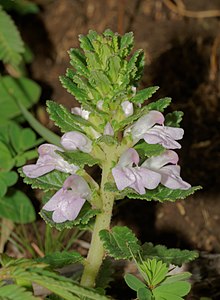
The Scrophulariaceae are a family of flowering plants, commonly known as the figwort family. The plants are annual and perennial herbs, as well as shrubs. Flowers have bilateral (zygomorphic) or rarely radial (actinomorphic) symmetry. The Scrophulariaceae have a cosmopolitan distribution, with the majority found in temperate areas, including tropical mountains. The family name is based on the name of the included genus Scrophularia L.

Gesneriaceae, the gesneriad family, is a family of flowering plants consisting of about 152 genera and ca. 3,540 species in the tropics and subtropics of the Old World and the New World, with a very small number extending to temperate areas. Many species have colorful and showy flowers and are cultivated as ornamental plants.

Paulowniaceae are a family of flowering plants within the Lamiales. They are a monophyletic and monogeneric family of trees with currently 7 confirmed species. They were formerly placed within Scrophulariaceae sensu lato, or as a segregate of the Bignoniaceae.

Striga, commonly known as witchweed, is a genus of parasitic plants that occur naturally in parts of Africa, Asia, and Australia. It is currently classified in the family Orobanchaceae, although older classifications place it in the Scrophulariaceae. Some species are serious pathogens of cereal crops, with the greatest effects being in savanna agriculture in Africa. It also causes considerable crop losses in other regions, including other tropical and subtropical crops in its native range and in the Americas. The generic name derives from Latin strī̆ga, "witch".
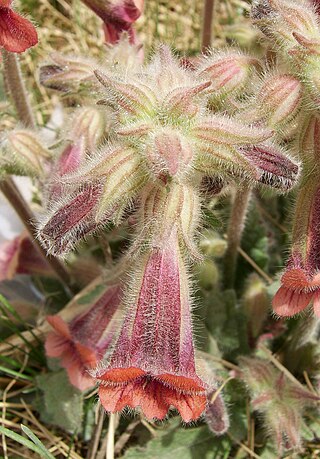
Rehmannia is a genus of seven species of flowering plants in the order Lamiales and family Orobanchaceae, endemic to China. It has been placed as the only member of the monotypic tribe Rehmannieae, but molecular phylogenetic studies suggest that it forms a clade with Triaenophora. Contrary to the immense majority of the taxa of Orobanchaceae, Rehmannia is not parasitic.

Calceolaria, also called lady's purse, slipper flower and pocketbook flower, or slipperwort, is a genus of plants in the family Calceolariaceae, sometimes classified in Scrophulariaceae by some authors. This genus consists of about 388 species of shrubs, lianas and herbs, and the geographical range extends from Patagonia to central Mexico, with its distribution centre in Andean region. Calceolaria species have usually yellow or orange flowers, which can have red or purple spots. The Calceolaria Herbeohybrida group, also called C. herbeohybrida Voss, is a group of ornamental hybrids known only in cultivation, called florists' slipperwort.

Rhinanthus is a genus of annual hemiparasitic herbaceous plants in the family Orobanchaceae, formerly classified in the family Scrophulariaceae. Its species are commonly known as rattles. The genus consists of about 30 to 40 species found in Europe, northern Asia, and North America, with the greatest species diversity in Europe.
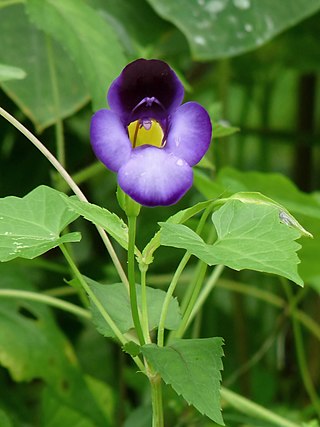
Torenia is a genus of plants now classified in the family Linderniaceae. Torenia has also been classified in the figwort family Scrophulariaceae. Often called wishbone flowers, bluewings; in Hawaii nanioola'a or ola'a beauty, some species are grown as garden plants. Many F1 and F2 Torenia hybrids have been hybridized in the last 30 years. Colors can range from white with yellow throats to violet, blue, cobalt, lavender and purple.

A parasitic plant is a plant that derives some or all of its nutritional requirements from another living plant. They make up about 1% of angiosperms and are found in almost every biome. All parasitic plants develop a specialized organ called the haustorium, which penetrates the host plant, connecting them to the host vasculature – either the xylem, phloem, or both. For example, plants like Striga or Rhinanthus connect only to the xylem, via xylem bridges (xylem-feeding). Alternately, plants like Cuscuta and some members of Orobanche connect to both the xylem and phloem of the host. This provides them with the ability to extract resources from the host. These resources can include water, nitrogen, carbon and/or sugars. Parasitic plants are classified depending on the location where the parasitic plant latches onto the host, the amount of nutrients it requires, and their photosynthetic capability. Some parasitic plants can locate their host plants by detecting volatile chemicals in the air or soil given off by host shoots or roots, respectively. About 4,500 species of parasitic plants in approximately 20 families of flowering plants are known.

Linderniaceae is a family of flowering plants in the order Lamiales, which consists of about 25 genera and 265 species occurring worldwide. Vandellia micrantha is eaten in Laos, but tastes bitter. Best known are the wishbone flowers Torenia fournieri and Torenia thouarsii, which are used as bedding plants, especially in the tropics. Micranthemum is sold as an aquarium plant when it is called 'baby tears'.
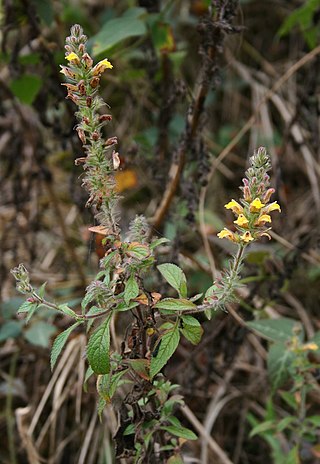
Lindenbergia is a genus of herbaceous plants in the order Lamiales and in the broomrape family Orobanchaceae. It is one of the few genera of the family which are not parasitic. It contains about 15 species found from northeast Africa across Asia to the Philippines, and is most abundant in India.
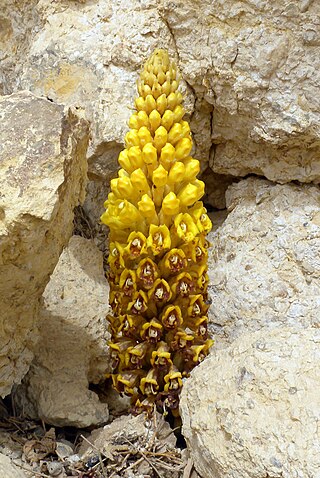
Cistanche is a worldwide genus of holoparasitic desert plants in the family Orobanchaceae. They lack chlorophyll and obtain nutrients and water from the host plants whose roots they parasitize. They are often known as desert hyacinths.

Orobanche minor, the hellroot, common broomrape, lesser broomrape, small broomrape or clover broomrape, is a holoparasitic flowering plant belonging to the family Orobanchaceae. It is one of about 150 non-photosynthetic plants in the genus Orobanche that parasitize autotrophic plants.
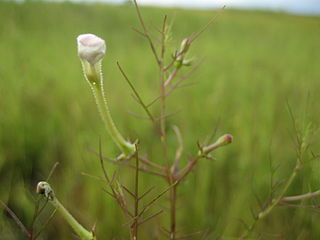
Rhamphicarpa fistulosa is a flowering plant species in the family Orobanchaceae - and the genus Rhamphicarpa. The plant is pale-green but can turn reddish towards maturity. It has needle-like leaves and white flowers with long corolla tubes. The flowers only open after sunset and are supposedly pollinated by night moths. The plant has a broad distribution in Africa and can also be found in New Guinea and northern Australia.
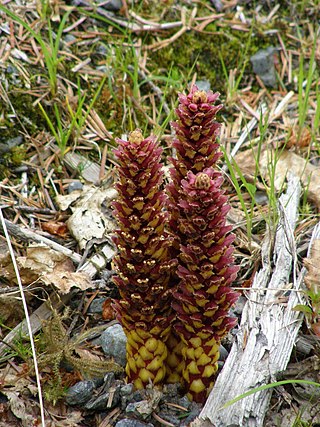
Boschniakia rossica, commonly known as the northern groundcone, is a holoparasitic plant that lives in the northern latitudes of the northern hemisphere. In the Pacific Northwest Temperate Rainforest, it does not grow south of Prince of Wales Island, beyond that boundary is the Vancouver groundcone habitat. It does not contain chlorophyll, so it must be parasitic to obtain nutrients. It specializes on Alnus species, but can parasitize off of other trees and shrubs such as on Betula (birch), Salix (willow), Vaccinium (blueberry), Picea (spruce), and Chamaedaphne. This organism is likely to be found at mid elevations alongside rivers and streams, where moisture is abundant. This species propagates itself through water flow. In some places bears are known to have eaten the starchy roots, or tubers, of this plant.

Orobanche hederae, the ivy broomrape, is, like other members of the genus Orobanche, a parasitic plant without chlorophyll, and thus totally dependent on its host, which is ivy. It grows to 60 cm (2 ft), with stems in shades of brown and purple, sometimes yellow. The flowers are 10–22 mm (0.4–0.9 in) long, cream in colour with reddish-purple veins.

Cycnium tubulosum, also known as the vlei ink-flower and the tissue paper flower, is a slender hemiparasitic perennial plant of the broomrape family. Its range includes much of southern and eastern Africa, from South Africa to Ethiopia, including Madagascar. It has creeping, straggling or upright stems, with few narrow, entire leaves and erect, white or pinkish, slightly zygomorph flowers on a long tube, with five lobes, reminiscent of a Phlox-flower. It may not always be fully dependent on the supply of minerals by other plants, but usually makes connections with the roots of grasses. It can be found in moist, short grasslands, reaching altitudes of about 1,550 m (5,090 ft). Its conservation status in South-Africa is "least concern".

Cycnium is a genus of flowering plants in the family Orobanchaceae. Its native range is tropical and southern Africa and Madagascar.
Triaenophora is a genus of flowering plants native to Temperate Asia. Its family placement is not fully settled, as of March 2022: it may be placed in Orobanchaceae or Plantaginaceae.




